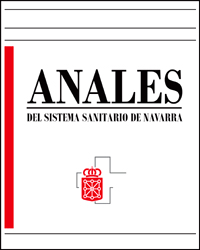Claves diagnósticas en el síndrome hemolítico urémico atípico: a propósito de un caso
##plugins.pubIds.doi.readerDisplayName##:
https://doi.org/10.23938/ASSN.1006Gako-hitzak:
Síndrome hemolítico urémico atípico, Anemia hemolítica microangiopática, Vía alternativa del complemento, Eculizumab, Proteínas del sistema del complementoLaburpena
El síndrome hemolítico urémico atípico (SHUa) es una entidad clínica caracterizada por anemia hemolítica no inmune, trombopenia y fallo renal, en la que las lesiones están mediadas por un proceso de microangiopatía trombótica (MAT) sistémica. Es una patología rara y cuyo origen es una desregulación del sistema del complemento debido a mutaciones en genes del mismo que llevan a una activación incontrolada de C5 y la formación del complejo de ataque de membrana. Su correcto diagnóstico permite prescribir el tratamiento basado en Eculizumab, inhibidor de C5.
Se presenta el caso clínico de una paciente gestante con SHUa, con el objetivo de destacar la importancia del diagnóstico diferencial precoz para el establecimiento temprano de un tratamiento efectivo de esta patología. Se actualiza la fisiopatología, diagnóstico y estudio genético, así como el manejo terapéutico del SHUa.
##plugins.generic.usageStats.downloads##
Erreferentziak
NORIS M, REMUZZI G. Atypical hemolytic-uremic syndrome. N Engl J Med 2009; 361: 1676-1687. https://doi.org/10.1056/NEJMra0902814.
TIMMERMANS S, WERION A, SPAANDERMAN M, REUTELINGSPERGER C, DAMOISEAUX J, MORELLE J et al. The natural course of pregnancies in women with primary atypical haemolytic uraemic syndrome and asymptomatic relatives. Br J Haematol 2020; 190: 442-449. https://doi.org/10.1111/bjh.16626.
CAMPISTOL JM, ARIAS M, ARICETA G, BLASCO M, ESPINOSA L, ESPINOSA M et al. Actualización en síndrome hemolítico urémico atípico: diagnóstico y tratamiento. Documento de consenso. Nefrología 2015; 35: 421-447. https://doi.org/10.1016/j.nefro.2015.07.005.
NORIS M, CAPRIOLI J, BRESIN E, MOSSALI C, PIANETTI G, GAMBA S et al. Relative role of genetic complement abnormalities in sporadic and familial aHUS and their impact on clinical phenotype. Clin J Am Soc Nephrol 2010; 5: 1844-1859. https://doi.org/10.2215/CJN.02210310
PEREIRA-VICTORIO CJ, VÁZQUEZ-MOLINERO A, LIZÁN-GARCÍA M, LUIS J, GONZÁLEZ B. Síndrome de HELLP en atención primaria. Med Gen y Fam 2016; 5: 83-90. http://dx.doi.org/10.1016/j.mgyf.2016.02.002
FAKHOURI F, ROUMENINA L, PROVOT F, SALLÉE M, CAILLARD S, COUZI L et al. Pregnancy-associated hemolytic uremic syndrome revisited in the era of complement gene mutations. J Am Soc Nephrol 2010; 21: 859-867.
https://doi.org/10.1681/ASN.2009070706.
NESTER C, BARBOUR T, RODRIGUEZ DE CORDOBA S, DRAGON-DUREY MA, FREMEAUX-BACCHI V, GOODSHIP T et al. Atypical aHUS: state of the art. Mol Immunol 2015; 67: 31-42. https://doi.org/10.1016/j.molimm.2015.03.246.
SHAH N, RUTHERFORD C, MATEVOSYAN K, SHEN YM, SARODE R. Role of ADAMTS13 in the management of thrombotic microangiopathies including thrombotic thrombocytopenic purpura (TTP). Br J Haematol 2013; 163: 514-519. https://doi.org/10.1111/bjh.12569.
NORIS M, BRESIN E, MELE C, REMUZZI G, ADAM M, ARDINGER H et al. Genetic atypical hemolytic-uremic syndrome. En: GeneReviews. Seattle (WA): University of Washington, 2021.
ROUMENINA L, FRIMAT M, MILLER E, PROVOT F, DRAGON-DUREY MA, BORDEREAU P et al. A prevalent C3 mutation in aHUS patients causes a direct C3 convertase gain of function. Blood 2012; 119: 4182–4191. https://doi.org/10.1182/blood-2011-10-383281.
MARTINEZ-BARRICARTE R, MEIKE HEURICH, LÓPEZ-PERROTE A, TORTAJADA A, PINTO S, LÓPEZ-TRASCASA M et al. The molecular and structural bases for the association of complement C3 mutations with atypical hemolytic uremic syndrome. Mol Immunol 2015; 66: 263-273. https://doi.org/10.1016/j.molimm.2015.03.248.
BRESIN E, RURALI E, CAPRIOLI J, SANCHEZ-CORRAL P, FREMEAUX-BACCHI V, RODRIGUEZ DE CORDOBA S et al. Combined complement gene mutations in atypical hemolytic uremic syndrome influence clinical phenotype. J Am Soc Nephrol 2013; 24: 475-486. https://doi.org/10.1681/ASN.2012090884.
Agencia Europea del Medicamento. Soliris (eculizumab). Ficha técnica. https://www.ema.europa.eu/en/documents/product-information/soliris-epar-product-information_es.pdfa 2012.
FAKHOURI F, FILA M, HUMMEL A, RIBES D, SELLIER-LECLERC A, VILLE S et al. Eculizumab discontinuation in children and adults with atypical hemolytic-uremic syndrome: a prospective multicenter study. Blood 2021; 137: 2438-2449. http://doi.org/10.1182/blood.2020009280
##submission.downloads##
Argitaratuta
##submission.howToCite##
Zenbakia
Atala
##submission.license##
##submission.license.cc.by-sa4.footer##La revista Anales del Sistema Sanitario de Navarra es publicada por el Departamento de Salud del Gobierno de Navarra (España), quien conserva los derechos patrimoniales (copyright ) sobre el artículo publicado y favorece y permite la difusión del mismo bajo licencia Creative Commons Reconocimiento-CompartirIgual 4.0 Internacional (CC BY-SA 4.0). Esta licencia permite copiar, usar, difundir, transmitir y exponer públicamente el artículo, siempre que siempre que se cite la autoría y la publicación inicial en Anales del Sistema Sanitario de Navarra, y se distinga la existencia de esta licencia de uso.








